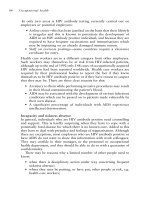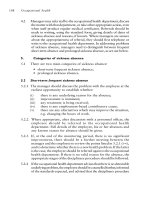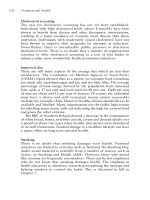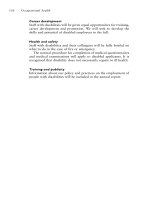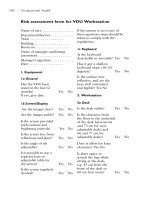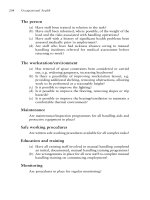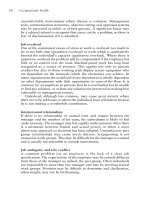Occupational health a practical guide for managers_6 pptx
Bạn đang xem bản rút gọn của tài liệu. Xem và tải ngay bản đầy đủ của tài liệu tại đây (424.31 KB, 24 trang )
108 Occupational health
4.2 Managers may refer staff to the occupational health department, discuss
the matter with that department, or take other appropriate action, even
when staff produce regular medical certificates. Referrals should be
made in writing, using the standard form, giving details of dates of
sickness absence and reasons, if known. Where managers are unsure
about the appropriateness of referral, they should first telephone or
write to the occupational health department. In addressing problems
of sickness absence, managers need to distinguish between frequent
short-term absence and prolonged sickness absence, as set out below.
5. Categories of sickness absence
5.1 There are two main categories of sickness absence:
• short-term frequent sickness absence;
• prolonged sickness absence.
5.2 Short-term frequent sickness absence
5.2.1 The manager should discuss the problem with the employee at the
earliest opportunity to establish whether:
(i) there is any underlying reason for the absence;
(ii) improvement is imminent;
(iii) any treatment is being received;
(iv) there is any employment-based contributory cause;
(v) there are any alternatives which may improve the situation,
e.g. changing the hours of work.
5.2.2 Where appropriate, after discussion with a personnel officer, the
employee should be referred to the occupational health
department. Full details of the employee, his or her absences and
any known reason for absence should be given.
5.2.3 If, at the end of the monitoring period, there is no significant
improvement, there should be a further meeting between the
manager and the employee to review the points listed in 5.2.1 (i–v),
and to determine whether there is a new health problem. If the latter
is the case, the employee should be referred again to the occupational
health department. If there is no valid reason for the absence, the
appropriate stages of the disciplinary procedure should be followed.
5.2.4 If the occupational health department advises that there is no detectable
underlying problem, the employee should be counselled further, informed
of the standards expected, and advised that the disciplinary procedure
Sickness absence 109
may be invoked. The employee should be told that continuation of this
level of absence could ultimately result in termination of employment
(on the grounds of incapability or misconduct). Following a warning,
the employee’s sickness record should be monitored carefully and review
dates arranged, as appropriate.
5.2.5 If the occupational health department advises that there is a
detectable problem, the manager will be advised in general terms
how the ill health is to be resolved.
5.2.6 The length of monitoring periods will depend on individual
circumstances and the post held by the employee.
5.3 Prolonged sickness absence
5.3.1 In these cases, the employee should be referred to the occupational
health department (normally after four weeks) for assessment on
the nature of the sickness and whether any improvement is likely.
At this stage, it may not be necessary for the employee to be seen
by the occupational health physician. If the manager needs advice
as to the best course of action, he may complete the referral form
or first contact the occupational health department. It may be
necessary to obtain information from the treating practitioner.
The employee will be asked to sign his or her agreement that
information from his or her GP or specialist may be sought by the
occupational health department. The employee will also be
informed of his or her rights under the Access to Medical Records
Act 1988.
5.3.2 Action following a medical report
The occupational health department will indicate any of the following:
(i) The employee is now able to return to work.
(ii) The employee will be able to resume work in a reasonable
period of time.
(iii) No improvement is likely.
(iv) The employee will be able to return to work subject to certain
conditions.
(v) It is too early for the occupational health department to give
a definitive view and a review of the employee’s health will be
undertaken within a specified time period.
(vi) The employee should be redeployed either temporarily or
permanently (see Section 7), or given long-term alterations of
duties in the present post.
110 Occupational health
5.3.3 Depending on the medical report, the following options should be
considered:
(i) If the occupational health physician believes that there is no
significant health problem, the employee should be advised
that he or she should return to work to carry out his or her
contract of employment satisfactorily. Failure to do this will
ultimately result in termination of employment.
(ii) Rehabilitation into the job, e.g. working part time initially
or undertaking restricted duties for a short period of up to
four weeks. (See Section 6.)
(iii) Redeployment to an alternative post. (If the post is of a
lower grade, protection does not apply: see Section 7.)
(iv) Early retirement on the grounds of ill health. (See Section 8.)
(v) Dismissal on grounds of incapability. (See Section 9.)
5.3.4 If the problem continues, it may be appropriate to refer the
employee again to the occupational health department, using the
referral form. The employer retains the right to obtain a further
medical opinion from a relevant specialist which will be arranged
through the occupational health department. The occupational
health department provides advice regarding future employment,
knowing the sickness problem of the employee and details of the
work. If the employee refuses, for any reason, to undergo an
examination, either by the occupational health department or
another relevant specialist, this could be construed as misconduct
because of a contractual commitment to undergo a medical
examination. Any decisions taken regarding the employee’s future
employment would be without the benefit of such information
and the employee should be advised accordingly. In certain cases,
a report from the treating doctor may be adequate. The view of
the occupational health physician should be sought before taking
further action.
6. Rehabilitation
6.1 This is designed to enable the employee, following long-term
sickness absence, to undertake gradually the full range of his or her
duties. This may include carrying out alternative duties or working
reduced hours, but normally only for a limited period of up to four
weeks.
6.2 The terms should be discussed with the personnel department.
Sickness absence 111
7. Alternative work
7.1 Advice should be sought from the occupational health department
on the decision as to whether to suggest to the employee that,
although he will not be fit to carry out the duties of his post, an
alternative job may be appropriate. The occupational health
department should advise on suitable posts. The alternative work
should be discussed with the employee and arrangements made for
him to be interviewed by the appropriate head of department.
Wherever possible, the employee should be given favourable
consideration. If there are no suitable posts within the organisation,
the personnel officer should, with the employee’s agreement, write
to other branches which are convenient for travelling to the
employee and establish whether they have any suitable posts.
8. Ill health retirement
8.1 Having received confirmation from the occupational health
department that the employee is not likely to return to work, is
unfit and expected to remain unfit to fulfil the duties of his post,
the head of department/ manager and personnel officer should
meet with the employee to explain the situation and suggest early
retirement (if the employee has two years’ superannuated service).
An application for ill health retirement will then be made by the
personnel officer.
8.2 If the ill health retirement application is approved, a representative
of the finance department will meet with the employee and
complete the retirement application form.
8.3 On termination of employment, the employee will receive a lump
sum pension payment and regular pension payments at specified
intervals. As the employee has applied for ill health retirement, a
notice period is not applicable.
8.4 If the application for ill health retirement is rejected, the procedure
for dismissal on grounds of incapability may be followed.
9. Dismissal on the grounds of incapability
9.1 If early retirement on the grounds of ill health is not possible, or
considered inappropriate, the personnel officer and the manager
should meet together to consider dismissal of the employee on
grounds of incapability, having first given consideration to
continuing to employ on alternative employment or changed
112 Occupational health
hours, if appropriate and possible. (Note that only dismissing
officers designated under the disciplinary procedure may
terminate an employee’s contract of employment.)
9.2 An employee dismissed for incapability has the right of appeal
against the decision of the organisation. Those employees with at
least 104 weeks’ continuous service can also apply to an Industrial
Tribunal, claiming unfair dismissal. The Tribunal will consider
whether or not, in the circumstances, the employer acted
reasonably in treating incapability as a sufficient reason for
dismissing the employee. The Tribunal will expect that
management has taken the following facts into account:
(i) the nature of the illness;
(ii) the employee’s length of service;
(iii) the expected length of a continuing absence;
(iv) the effect of absence on the department’s operational
efficiency;
(v) the sickness record.
10. Advice
Advice should always be sought from the personnel department to
ensure consistency of approach within current legal regulations.
113
Chapter 7
Smoking in the workplace
How can the smoker and the non-smoker be equally free in the
same railway car?
(George Bernard Shaw)
It has been estimated that 50 million working days are lost to British
industry every year from smoking-related sickness absence. The
increasing evidence that passive smoking may also lead to illness and
death means that tobacco smoke could now be regarded as a toxic
hazard. The responsible employer should initiate a programme to
minimise smoking in the workplace, not only for the promotion of
health but also in line with the requirements of health and safety
legislation. This chapter looks at the current legal position and
explores ways of producing a smoke-free atmosphere in the workplace.
Rest rooms and rest areas must include suitable arrangements to
protect non-smokers from discomfort caused by tobacco smoke.
Guidance on the development of a formal written smoking policy is
given and the case for encouraging all employees to increase their
health awareness is outlined.
Introduction
There can be little doubt that smoking in the workplace is an issue with
which management must engage. It has been estimated that 50 million
working days are lost to British industry every year from smoking-related
sickness absence. For this reason alone the responsible employer should
look for initiatives which will discourage smoking in the workplace.
The use of tobacco is ubiquitous. About 13 million adults in the UK
smoke cigarettes, accounting for 80 per cent of tobacco consumption.
There are two types of tobacco smoke: mainstream smoke, inhaled and
exhaled by the smoker, and sidestream smoke which is released directly
into the atmosphere from the cigarette. This contains a higher concentration
of the tobacco chemicals, including known carcinogens. Sidestream smoke
114 Occupational health
forms the greater part of environmental tobacco smoke (ETS). Lung cancer,
which has been linked to smoking, kills over 40,000 people in the UK each
year, 90 per cent of whom are smokers. Other forms of cancer are also
more common in smokers. However, cardiovascular disease, including heart
attacks, remains the major cause of death in smokers.
Other health effects of ETS are recognised including irritation and
discomfort of the mucous membranes, exacerbation of adult asthma and
increased incidence of heart disease.
Legal considerations
Since ETS is now recognised as a health hazard the requirements of
health and safety legislation apply. This has not yet been tested in the
courts. In 1993 there was an out-of-court settlement between Veronica
Bland and Stockport Borough Council in which Mrs Bland claimed that
her health had been damaged by ETS. It is known that further cases are
in preparation. Relevant legislation includes the following.
Health and Safety at Work etc. Act 1974
This Act underpins much of the other health and safety legislation. It
requires all employers to promote and ensure the health and safety of
their employees and provide a safe workplace.
Workplace (Health, Safety and Welfare)
Regulations 1992
These are part of a group of six regulations (the six pack) promulgated in
1992 and stemming from the EC Framework Directive. Regulation 25(3)
states: ‘Rest rooms and rest areas shall include suitable arrangements to
protect non-smokers from discomfort caused by tobacco smoke.’
Existing current work areas must comply by 1 January 1996, while
new or significantly altered workplaces must comply as soon as they
come into use.
Management of Health and Safety at Work
Regulations 1992
Another one of the ‘six pack’, these impose a duty to assess all risks to the
health and safety of the individual worker and eliminate the hazards
present. There is no doubt that the risk associated with the hazards
presented by passive smoking must be assessed and reduced.
Smoking in the workplace 115
Providing an atmosphere free from tobacco smoke
Apart from the obligation to produce a smoke-free atmosphere, the
employer may see other, more general, advantages in providing such an
atmosphere, namely a reduced fire risk and reduced absenteeism. On the
negative side, companies should be aware that implementing a smoking
policy will cost both time and money: time in consultation, negotiation
and attendance of counselling/support groups; money for the purchase
and dissemination of posters and educational literature. The only certain
way of achieving a smoke-free atmosphere is to ban smoking in the
workplace. It is not recommended that this be imposed by a top-down
edict. On the contrary, it is strongly recommended that the workforce are
made familiar with the legal requirements and the health case so that
they can take part in the decision-making, implementation, monitoring
and development of the smoking policy in an informed way. It is argued
that to implement such a change, without detailing the provisions and
facilities for smokers, including those designed to assist smokers who
wish to stop, would be seen as unfair, and would call for a high level of
subsequent workplace supervision.
Development of a smoking policy
Action on Smoking and Health (ASH), in collaboration with other
interested parties including the Health Education Authority, has
produced a guide to good practice in workplace smoking. The steps
recommended in the development of a company smoking policy are:
• preparing for action;
• taking action;
• launching the policy;
• making it work.
Preparing for action
The best way of ensuring that action on smoking at work is successful is
to make the smoking policy reflect the wishes of the workforce, as far as
possible. One of the best ways of doing this is to circulate a questionnaire
(the purpose of which is explained in advance) to the whole workforce or
a representative sample.
One of the most effective ways of organising a questionnaire and
planning subsequent action is to set up a small working party. Such a
party should represent the views of smokers and non-smokers, and
116 Occupational health
should include representatives of management and, where recognised,
trade unions.
Before any action is taken, it is important to review current practice by
asking the following questions:
• Is there any existing policy on smoking, written or otherwise?
• In which areas is smoking currently restricted and why?
• Do some groups of workers seem to smoke more heavily than
others? Does this relate to working conditions?
• Have there been any cases of:
–non-smokers complaining of a smoky atmosphere or bad
ventilation?
– smokers unduly restricted in areas where they can smoke?
– smokers asking for assistance in giving up?
• Who did these workers complain to, and what happened?
• Is there any special hazard?
The nature of the industry or work may make smoking particularly
dangerous: for example, the risk of contracting lung cancer in a smoker
who is also exposed to asbestos dust is around 55 times greater than that
of an ordinary non-smoker, since the effects of asbestos and tobacco
smoke chemicals appear to be cumulative. Specific factors such as these
may be strong motivators.
The answers to these questions, in conjunction with the questionnaire,
help to indicate the kind of policy which may be suitable. It is also
important, however, to clarify why action is being taken and its aims.
Questionnaires
The questionnaire requires a great deal of thought as it must avoid any
suggestion of bias in the way questions are phrased and be seen as
appropriate and relevant to the people to whom it is addressed.
Each organisation will need to develop a questionnaire appropriate to
its own requirements. A letter explaining the purpose of the
questionnaire helps to establish the reason for its circulation and the
possible outcomes. A questionnaire should also attempt to establish
prevailing staff attitudes. Staff must also be assured that the results of the
survey will be fed back to them. A sample questionnaire and other
written communications to employees are given at the end of this chapter
(see pages 119–22). The working party should set a timetable for
assessment, the reporting of results, proposals for a smoking policy and
implementation.
Smoking in the workplace 117
Taking action
Written policies
The advantages of a formal written policy are self-evident: it is a
reference document, an indication of commitment, a gesture of
encouragement and a definition of responsibility. (A sample policy is
given at the end of this chapter: see page 123.)
Depending on the internal administrative practices of the
organisation, a policy statement may be supported by a company manual
providing background information, advice, administrative instructions,
responsibilities and accountabilities. An extract from a management
manual is given at the end of this chapter (see page 124).
According to the National and Local Government Officers’
Association (as it then was), there are six clear negotiating options for
restricting smoking in working areas:
• Opt-in scheme: smoking is allowed until one or more persons
object.
• Each office/department/section is to determine its own restrictions.
• Opt-out scheme: unless everyone is in agreement that it should be
allowed, smoking is banned in all working areas.
• Majority decision: the working area is designated smoking or non-
smoking by a majority vote.
• Smoking is restricted to specific times: for example, during tea or
coffee breaks.
• Total ban: smoking is prohibited at all times in all working areas.
Once a policy has been established, it is clearly important to encourage
compliance with it. The disciplinary procedure for those who break the
restrictions should be well publicised and the success of the policy should be
monitored regularly. Once established, a smoking policy should not be deemed
to be written in tablets of stone: monitoring its effectiveness must involve
considering whether or not it needs to be changed in the light of changing
smoking patterns, or in response to any problems which have emerged.
Launching the policy
The success of a smoking policy can be helped by careful timing of its
launch and by taking advantage of internal and external publicity. For
example, companies may consider it advantageous to co-ordinate the launch
with National No-Smoking Day or with the Budget—both occasions which
generate considerable media and public interest in smoking. Outside
118 Occupational health
agencies can help; ASH and the Health Education Authority both produce
useful literature—either free or at a low cost—which can be circulated to
employees. The launch should be well publicised internally by the prominent
display of notices. An exhibition could be mounted, and participatory
exercises—such as lung function tests—could be made available. Companies
could consider the advantages of introducing a smoking policy as part of
a general campaign towards increased health awareness. Integrating a
smoking policy in this way perhaps prevents smokers from feeling
‘victimised’ and encourages all employees to take a greater interest in health
issues in general.
Making it work
The old adage that ‘the care and effort put into the management of the
change will reflect in the quality of the implementation’ applies.
Commitment to the new circumstances should be as obvious as possible.
The policy will need to be supported in all parts of the organisation. This
commitment will require a consistent approach and a willingness to
invest time and money, and to subordinate the short-term interest for the
longer-term good. It is recommended that, if a working party has been
used in the research, development and implementation of the policy, it
should continue to meet and have responsibilities until such time as the
new situation has become a way of life and can safely be left to general
consultative, participative arrangements. One way of showing
commitment is by regular follow-up to check staff satisfaction and
developments.
Of particular benefit is National No-Smoking Day which will offer
not only resources for an in-house programme but provide aims and
objectives, ideas for action, and a range of printed images and factsheets
which can be used in a local campaign, as well as posters, leaflets and
stickers.
Conclusion
Like good law, the achievement and maintenance of a responsible
smoking policy, and good practice within an organisation, will benefit
from the belief that the policy is necessary, fair, balanced and
appropriate.
Experience shows that the perception of these factors relies on a well-
considered strategic approach: one which involves and takes notice of the
views of those to whom the policy applies, non-smoker and smoker alike.
Smoking in the workplace 119
Introductory letter
Dear Colleague
Developing a smoking policy
You may have seen the recent publicity in the press and TV about
the possible hazards to a person’s health from exposure to the
smoke of an active smoker—‘passive smoking’.
Employees have raised the question of this health risk through the
Health and Safety Committee. The Committee agreed that a
working party of employees should look into the problem, and, in
the interests of employees’ health and safety, recommend whether
the company should introduce a policy which (a) restricts smoking
at work in some form and (b) provides support to people who want
to stop smoking.
The members of the working party are:
Dr—, the company doctor, has produced a brief summary on
passive smoking and the current view of the health risks involved.
This is attached for you to read.
Before considering any form of policy on smoking, the working
party wants to know the views and preferences of employees across
the company. We would be grateful, therefore, if you would
complete and return the attached questionnaire.
This could affect you, so please take a few minutes to complete and
return this form. It is important that we know what you think
about smoking at work.
Thank you in anticipation of your co-operation.
Yours sincerely
For and on behalf of the Smoking Working Party
120 Occupational health
Questionnaire on smoking at work
Please complete this questionnaire and return it in confidence to the
personnel department.
PLEASE CIRCLE THE LETTER WHICH CORRESPONDS
WITH YOUR PREFERRED CHOICE
1. Should there be more restrictions on people smoking at work
than there are at present?
A. Yes.
B. No.
2. Which best describes your view of what the company policy on
smoking should be?
A. A total ban on smoking on site at all times.
B. A total ban on smoking on site except in designated
‘smoking areas’.
C. Smoking permitted with increased restrictions in work and
rest areas.
D.Each work area should be allowed to make its own decision
whether or not to restrict smoking, i.e. a majority vote.
E. No change to the current situation.
F. Other; please specify.
3. Which of these best describes your view about smoking in your
work area?
A. There should be no smoking except at break times.
B. Smoking should not be allowed.
C. There should be separate areas where smoking is permitted.
D.Smoking should be allowed in all areas.
E. There should be a majority vote on whether smoking is
allowed.
F. Other.
4. For each of the listed areas, specify your preferred choice. The
choices are:
A. No restrictions on smoking.
B. Separate areas for smokers.
C. Smoking permissible only at specified times.
D.A total ban on smoking.
Smoking in the workplace 121
The areas are:
Reception area A B C D
Corridors A B C D
Meeting rooms A B C D
Canteen A B C D
Rest rooms A B C D
Toilets A B C D
Company vehicles A B C D
5. Which of the following describes your working area best?
A. Private office.
B. Private office but used by others outside your working hours
(i.e. shifts).
C. Office shared with small number of other people.
D.Open plan office.
E. Shop floor.
F. Other; please specify.
6. Which of the following describes you best?
A. I am a smoker who wants to give up.
B. I am a smoker who doesn’t want to give up.
C. I am an ex-smoker.
D.I am a non-smoker.
122 Occupational health
To: All employees
From: The Smoking Working Party 1 December 199X
Summary of results of questionnaire on smoking
A total of 387 people replied: 69.5 per cent indicated that there should be
more restrictions on smoking at work; 28.9 per cent indicated that there
should be no change.
The individual views of respondents on a company smoking policy
were as follows:
(a) A total ban on site 20 per cent
(b) A total ban except in designated areas 36 per cent
(c) Permitted smoking with increased restrictions 17 per cent
(d) Majority vote for each work area 9 per cent
(e) No change 18 per cent
Of the respondents, 27 per cent were smokers, half of whom want to give
up, and 67 per cent would like help to give up.
Seventy-nine per cent of respondents indicated concern over health
problems associated with smoking. Thirteen per cent felt the need to
move away frequently from smokers at work and 37 per cent only
occasionally felt the need to move away.
Sixty-five per cent of smokers who responded felt that it would be
difficult if they could not smoke during working hours.
Sixty-eight per cent of respondents believe that the question of
smoking should not be considered when recruiting new employees.
The Committee will now undertake an in-depth analysis of the
questionnaire and draft a policy on smoking at work for discussion at the
Consultative Health and Safety Committee.
(
Smoking in the workplace 123
A smoking policy
We would like to draw your attention to the fact that this company has
a smoking policy which represents the views and wishes of our
employees.
The main aim of the policy is to ensure a smoke-free atmosphere for
employees and visitors.
The policy restricts smoking to specific designated areas throughout
the company and these are clearly marked.
If you wish to smoke, you are therefore requested to smoke only in
one of these areas.
Thank you for your co-operation.
124 Occupational health
A manager’s manual on smoking policy
Introduction
The company has adopted a formal policy to reduce workplace
smoking; this complements existing health and safety commitments
to provide a healthy environment and promote personal health care
within the company.
Policy
Cigarette smoking is the most preventable cause of premature death
and disability in the UK. Therefore, in consideration of the health
and well-being of all its employees, the company is committed to the
development of programmes to reduce smoking in the workplace
and to assist smokers in their efforts to stop smoking.
Responsibility
Disciplinary action
Any person smoking in a non-smoking area will be counselled
within the scope of the company disciplinary procedure.
Annual review
The policy will be reviewed annually.
Why are we implementing this policy?
We aim to safeguard and improve the health of our employees by:
• promoting awareness of health hazards;
• protecting non-smokers from smoke by reducing the effects of
passive sidestream smoke;
• encouraging smokers to stop.
General
This policy is intended to increase all employees’ awareness of the
dangers of smoking and maintain employee health throughout
employment with the company. Employees and prospective employees
should be made aware of this policy with the specific aim of seeking
their support, and it is their responsibility to ensure it is maintained.
125
Chapter 8
Health promotion in the workplace
Accept change or remain behind in a state of shock.
(Alvin Toffler)
The Health Of the Nation targets five areas: coronary heart disease,
cancers, mental illness, HIV/AIDS and accidents. All these are important
and conducive to education in the working age group; initiatives in the
workplace are seen as part of the strategy. This chapter looks at the
business and the moral case for health promotion in the workplace. The
cost to industry of unhealthy lifestyles is explored and some attempt is
made to demonstrate the effectiveness of health education. The chapter
goes on to consider the appropriateness of health promotion activities,
including screening, education and the creation of a healthy environment
The criteria for workplace screening are outlined, with reference to the
government’s target areas. The development of an action plan is
described, including assessing organisational needs and defining relevant
target groups.
Introduction
There are about 26 million people in full- or part-time work in the UK,
spending up to 60 per cent of their waking lives in their places of work.
The government publication The Health of the Nation has targeted five
areas where the nation’s health can and should be improved, to bring it
into line with comparable countries. These are:
• coronary heart disease and stress;
• cancers;
• mental illness;
• HIV/AIDS and sexual health;
• accidents.
None of the targets proposed can be achieved by action solely at work,
although all are important to the working population. Of course,
126 Occupational health
employers cannot take responsibility for the lifestyle of their employees,
although they can reasonably be expected to aim for no work-related ill
health or accidents.
In the same document the Department of Health has indicated that it
will be exploring ways of creating national and local networks to draw
together scarce public health skills. For smaller organisations these sorts
of initiative may be the only cost-effective way of providing health
promotion for their employees.
The business case for health promotion
At shop floor level the increased use of information technology and
closed systems of work have tended to increase the value of individual
members of the workforce. The complexities of organisations and their
speed of change, which characterise the 1990s, require good
management with well-developed special skills. Organisations, therefore,
cannot afford to lose good personnel in whom much money may have
been invested. Nor is it possible for companies to function efficiently if
less than optimum performance results from deleterious lifestyle and
poor health.
Information on the benefits of health promotion in the workplace is
sparse in relation to the enormous amount of activity in this area. Many
studies have looked at the impact of drinking and smoking in the
workplace. Ryan et al. (1992), in a prospective study of 2500 postal
employees, calculated the relative risk between smokers and non-
smokers in four areas: turnover, accidents, injuries and indiscipline. See
Table 8.1.
Ryan et al. showed that smokers had 25 per cent more accidents and
when these occurred they had 40 per cent more chance of injury.
Examples of indiscipline increased over 50 per cent. There appeared to be
no related increase in turnover. They also demonstrated an increased
sickness absence level in smokers, the mean rate being 5.43 per cent for
smokers compared with 4.06 per cent for non-smokers. Similarly, Gabel
(Gabel and Colley Niemeyer 1990), looking at staff in a public health
Table 8.1 Increased employment risk associated with smoking
Health promotion in the workplace 127
agency, showed that smokers had more sickness absence, took less
exercise and had a poorer diet.
Jenkins undertook a six-year longitudinal study of the occupational
consequences in white-collar workers of drinking over the safe limit of
alcohol (Jenkins et al. 1992). He showed that even moderate alcohol
consumption substantially increased sickness absence and was associated
with lack of promotion for men. In a detailed study of the Du Pont
company, Bertera (1991) demonstrated an excess annual illness cost per
person associated with five behavioural risks. See Table 8.2.
The only behavioural risk not associated with a significant increase in
sickness absence costs was lack of exercise. The Royal College of
Physicians has estimated that 50 million working days are lost each year
from smoking-related diseases. The likely cost in terms of lost production
is over £2500 million. Alcohol-related disease is estimated to cost £700
million in sickness absence alone.
The case for the cost to industry of poor lifestyle has been made. What
is less convincing is the effect of health promotion and the possible benefit
to individual organisations. Generally, outcomes have not been measured,
although Leviton (1989) has developed a model to assess the likely benefits
of health promotion in a number of areas. He showed that screening for
high blood pressure paid for itself. In some organisations smoking cessation
programmes were also self-financing. However, he was unable to
demonstrate any significant payback from cholesterol screening. The
Johnson & Johnson and Du Pont corporations have both been able to
demonstrate a reduction in sickness absence costs (between 9 and 20 per
cent) following the introduction of an employee assistance programme.
There are probably a number of reasons why the effect of health
promotion in the workplace has been poorly measured. The workplace
does not lend itself to randomised studies, hence the lack of controlled ones.
It is inevitable that any health promotion activity aimed at volunteers in a
Table 8.2 Behavioural risks
128 Occupational health
general workforce will receive more attention from those who are already
aware. The intervention group is, therefore, considerably biased. Staff
turnover interferes with long-term follow-up and organisational change
may have an independent impact on outcomes. Few organisations have
good epidemiologically based sickness absence statistics. Finally, there may
be a considerable time-lag before health effects can be identified.
The outcomes that might be expected from successful health
promotion are:
• a reduction in sickness absence;
• reduced staff turnover;
• improved productivity;
• improved morale;
• a reduction in the loss of key personnel;
• enhanced recruitment.
Other reasons for introducing health promotion are: specific fitness
requirements for certain jobs, such as fire brigade personnel and catering
staff; as an adjunct to statutory requirements new health and safety
legislation is tending more towards individual fitness for the job. For
example, the Manual Handling Operations Regulations require an
assessment of the operator’s fitness for each task.
All the outcomes would, of course, be important gains, but it is likely
that organisations which embark on a full health promotion programme
may have other motives which one could describe as the moral case.
The moral case for health promotion
Since the business case for health promotion has not yet been proved,
why should organisations promote health at work? There are a number
of reasons which could be described as purely altruistic and which
demonstrate a more holistic approach to workforce well-being and a
commitment to the health of the nation:
• as an expression of corporate commitment to the care of staff;
• as part of a benefits package;
• a desire to be seen as a ‘good employer’.
These reasons fall under the umbrella of ‘health promotion is a good thing’
and may engender a feeling of paternalism in senior management. This
seems to be an additional reason for the paucity of follow-up studies, since
it is the process, not the outcome, which is seen as important.
Health promotion in the workplace 129
Workplace initiatives
The possible reasons why an organisation should consider health
promotion initiatives have been fully discussed above. It is easy to target
a workforce as it is a captive population. It is also convenient for the
individual employee. The workforce constitutes a good age profile for
health promotion and it is of economic importance to protect this group.
However, consideration must be given to appropriate health
promotion topics in any one workplace. The health promotion needs of
the workforce may be ill perceived and inappropriate (see Cholesterol
screening, page 132). Certain criteria should be used in deciding on
workplace initiatives:
• Action in the workplace must be appropriate. Certain areas may be
seen by employees as constituting unwarranted interference in their
personal lives.
• The initiatives should complement or be more efficient than those
in the community. Government initiatives in recent years have
much enhanced health promotion and screening activities in
general practice. There is no point in duplicating these activities.
• The initiatives must complement activities concerned with the
promotion of health at work. For example, a reduction in alcohol
consumption may form part of an accident prevention programme.
• There are opportunities for collaboration with outside agencies
such as the Health Education Authority (HEA). This maximises the
use of available health promotion material. The HEA’s Look After
Your Heart campaign relies heavily on joint working relationships.
• The message to be conveyed should be clear and uncontroversial.
The continuing debate about the significance of moderately raised
cholesterol levels provides a good example of a confused message.
• It must be possible to set targets and measure outcomes.
Scope for workplace initiatives
There are three types of intervention: screening, education and creating a
healthy environment. Topics commonly considered as appropriate for
workplace health promotion are:
• coronary heart disease;
• smoking;
• alcohol;
• stress;
• cancer.
130 Occupational health
Criteria for screening in the workplace should be narrow. The factor
chosen should:
• be appropriate to the working age population;
• be appropriate to the particular workforce;
• have clear boundaries of normality;
• have effective treatment available;
• have screening techniques which are acceptable in the workplace
and not disruptive;
• not be easily available elsewhere.
Education and screening
Coronary heart disease
In the UK, coronary heart disease accounts for 26 per cent of deaths. This
is one of the highest levels in the world, the single largest cause of death
and the single main cause of premature death.
Strokes, which have similar risk factors, account for a further 12 per
cent of deaths. The government objective is to reduce deaths from
coronary heart disease by 30 per cent by the year 2000 and to reduce
deaths from strokes by 40 per cent.
Risk factors known to be associated with these disorders include:
• obesity;
• hypertension;
• high cholesterol;
• stress;
• smoking;
• excessive alcohol consumption;
• genetic factors.
All these, except the last, are amenable to health education.
A major contribution to health promotion in relation to coronary
heart disease is the HEA’s Look After Your Heart (LAYH) campaign,
launched in 1987. Its workplace initiative requires employers to sign up
for three out of a list of ten initiatives:
• provide information on health issues;
• develop a comprehensive smoking policy;
• provide and promote healthy food choices;
• introduce physical activity programmes;
• promote sensible drinking;
Health promotion in the workplace 131
• identify sources of stress and provide staff support;
• provide health checks;
• provide an environment conducive to health;
• use LAYH workplace services;
• explore new initiatives on health.
To date, the programme is available to 3.5 million employees. Becoming
part of this campaign is usually a high-profile activity and the HEA
expects to have support from the highest level of management in the
organisation. The HEA provides promotional material and expert
advice, and this may be particularly useful for smaller companies which
do not have in-house expertise. In larger companies the initial
commitment may be followed by related activities within the
organisation, including fitness assessment, exercise classes, blood
pressure screening, improved dietary choices in staff restaurants,
slimming clubs and running clubs.
Fitness
There are various fitness assessment packages available. These generally
measure heart and lung capacity by measuring pulse rates before and
after some form of controlled activity, such as a step test or the use of the
bicycle ergometer. Most of these packages include a basic lifestyle
questionnaire and provide a useful printout on the individual’s current
state of health, with comments and advice on lifestyle and possible
improvements.
Organisations offering fitness assessment to their employees often find
it beneficial to provide exercise facilities, such as group membership of a
local health club; an in-house gymnasium (occasionally a swimming
pool); exercise classes; individual exercise packages; formation of
running clubs, etc.
Blood pressure screening
It is common for individuals to be unaware that they have raised blood
pressure (hypertension) because until high levels are reached the
condition may be symptom-free. Hypertension is easy to treat and
control; uncontrolled, it may lead to coronary heart disease and
strokes. Identifying raised blood pressure is, therefore, an important
health promotion activity. It is simple to carry out, takes minimum
time, causes little disruption and can be undertaken by nurses. Apart
from the occasional individual who may become anxious because a
raised blood pressure is detected, the activity seems to be wholly
beneficial.



